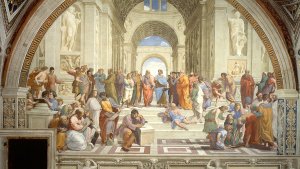Instruction is a trendy word in education. Countless publications dwell on strategies for instructing students in reading and math, science and language arts, classroom behavior and good citizenship. Professional development courses train teachers in new methodologies. Students practice test taking, note taking, narrating, annotating, mapping, diagraming, executive functioning, and stress management. For all its usefulness, overemphasis on skills often obscures fundamental questions about what to study and why.
As is often the case, a very old idea sheds comforting light on modern confusion. Indeed, one of the most effective approaches to clarifying the content and purpose of study derives from the classical trivium, the ancient division of education into grammar, dialectic, and rhetoric. The trivium organizes learning into focused, though often overlapping, stages that lead students from elementary studies to mastery.

GRAMMAR
The Art of Memory
Grammar, the first building block of education in the classical tradition, teaches young children primary knowledge. At this stage, learning proceeds by mainly memorization. The key is to systematically present children with worthwhile knowledge to assimilate through imitation and repetition. To start, children acquire language. Without any effort, they learn to speak simply by mimicking sounds. Given the opportunity, they’ll master one, two, or even three languages without the slightest hesitation over syntax, inflection, or vocabulary. With time, they’ll progress to the alphabet (or two if you teach them). Memorization allows children to absorb knowledge of astonishing breadth, such as spelling, math facts, and the periodic table; classical music and dance routines.
Have you ever heard little kids playing Bach? Or watched your niece’s tap recital? Taught without coercion, ordinary youngsters accomplish astonishing feats of sensory, long- and short-term memory. If you encourage them, they’ll rattle off historical dates and all the presidents of the United States. Sing songs and recite poetry. Recall the Ten Commandments and the 12 apostles. The list expands with every bit of knowledge the child encounters, imitates, practices, and absorbs over time. Every discipline possesses a ‘grammar,’ a range of knowledge required for subsequent mastery. Memorization offers the easiest way to teach the necessary facts.
Dialectic
Learning to think logically
Equipped with organized bodies of knowledge, teenage brains are ripe for logical reasoning and analysis. This is dialectic, the second stage of the trivium. All the knowledge amassed during the grammar stage comes to bear on the process of learning to think logically by linking information into coherent units of thought, detecting gaps in reasoning, and calling out falsehoods. Teens love to argue. Teach them how. Let them throw down the gauntlet, then return the challenge: Can you define the problem? Whence does the question arise, and what follows when we answer it in this way… or that? What do other credible people say? Can we compare this question with similar questions, and what does the analogy reveal? What else might be happening to help us put the question in context?
Learning at this age is best nourished by practicing how to discern cause and effect, spot fallacious thinking, and build sound arguments. To see what he thinks, a teenager should write frequently. If possible, sign him up for a formal course in logic. Or you can just talk during family meals or car rides. Parents need not be experts. Follow your teens’ interests: baking, pet lizards, supernovas; dating, workouts, fantasy novels. Whether academic, eccentric, or perfectly commonplace, those pursuits will turn into learning when teens engage them with a healthy respect for facts and their relations.
Rhetoric
The art of persuasion
Equipped with knowledge and armed with the tools of logical reasoning, older students arrive at rhetoric, the last stage of the classical trivium. Rhetoric is the art of effective persuasion. It finds appropriate expression for arguments built on facts (grammar) and buttressed by understanding (dialectic). At the rhetoric stage, students present ideas to others through discussions, debates, writing, public speaking, and the like. They can now argue responsibly because they have mastered foundational knowledge and have acquired means to explain ideas cogently. Their claims derive from facts and reasoned analysis, not hearsay or opinion. Using their store of sound knowledge and clear reasoning, they can also apply ideas.
Creative pursuits, independent studies, problem solving, multi-step projects — coupled with ongoing conversation and argument — drive the rhetoric student. Perhaps you know that young adult who taught himself masonry? He’s now rebuilding his parent’s house after a fire. Or the neighbor’s daughter who spent COVID lockdowns figuring out the basics of computer programming? She’s now attending university on a STEM scholarship. Or the college graduate who nailed interviews and application essays to receive a full ride to a PhD program? Their knowledge and understanding have borne fruit in effective presentation and application of ideas, launching them toward mastery in their respective fields.

A journey toward meaning
By mapping out how and what to study at different stages of development, the ancient trivium brings students to the threshold of mastery. Attained through specialized learning and life experience, mastery rises above mere statement of facts or their connections. Rather, it grasps and communicates what the connections mean and why they matter.
Momentous discoveries and paradigm shifts have occurred as a result of recognizing the meaning and implications of related facts. Copernicus worked with the same calculations, charts, and diagrams as other astronomers. His genius, however, was to realize the truth they signified, thus proving the heliocentric structure of the solar system. Everywhere, good doctors interpret the meaning of symptoms, treating the underlying causes instead of surface effects. For astute historians, descriptions of major events and particulars of everyday life disclose processes that change how we perceive the past.
A wonderful resource: ‘How to Read a Book’
One of the most valuable recommendations for students and those of us who, as parents and professionals, take study as a lifelong endeavor can be found in Mortimer Adler and Charles van Doren’s classic How to Read a Book. Adler and van Doren argue that reading what feels beyond us is necessary to advance our learning. Merely adding information to existing mental files expands our command of facts, but it doesn’t transform our thinking. On the other hand, by contending with ideas just beyond our reach we begin to stretch our minds. To this end, we should read difficult things, those that challenge us cognitively and demand consideration of novel points of view.
This kind of reading — which is really another word for study — broadens what we know and elevates how we think. It enables an ever-deepening encounter with reality. And such an encounter is perhaps the ultimate reward of study.



